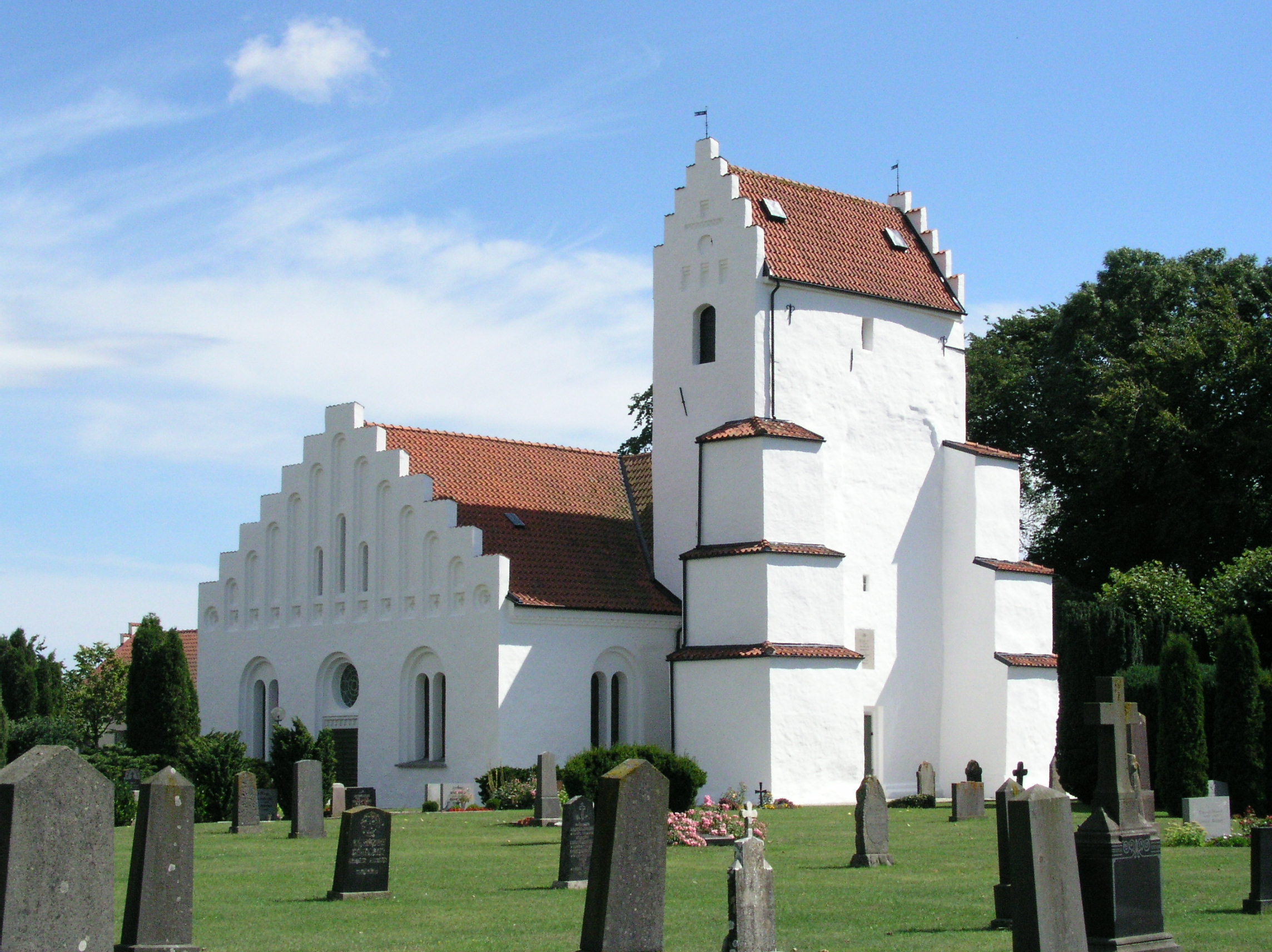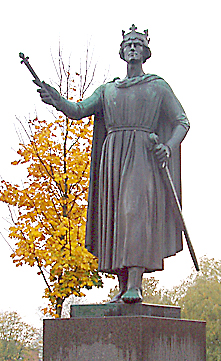|
Majestatis
Majestatis ( la, Magister Majestatis Domini, ''The Master of Christ in Majesty'', usually shortened to Majestatis and sometimes referred to as the Tryde Master, fl. second half of the 12th century) was a Romanesque stone sculptor and the creator of several richly decorated baptismal fonts mainly in Scania and on Gotland (present-day Sweden). Life and works The name ''Majestatis'' is a notname assigned to the artist or workshop; it is possible that an atelier rather than a single artist was responsible for the works attributed to Majestatis. Art historian Johnny Roosval coined the name in the 20th century. It derives from a subject often used by the artist, Christ in Majesty sitting on a rainbow and surrounded by a mandorla and angels. No written sources exist about the life or background of the artist, but it has been speculated that Majestatis was trained in Burgundy or Alsace or may have come from there. Majestatis initially seems to have worked in Scania, probably for the lo ... [...More Info...] [...Related Items...] OR: [Wikipedia] [Google] [Baidu] |
Christ In Majesty
Christ in Majesty or Christ in Glory ( la, Maiestas Domini) is the Western Christian image of Christ seated on a throne as ruler of the world, always seen frontally in the centre of the composition, and often flanked by other sacred figures, whose membership changes over time and according to the context. The image develops from Early Christian art, as a depiction of the Heavenly throne as described in 1 Enoch, Daniel 7, and The Apocalypse of John. In the Byzantine world, the image developed slightly differently into the half-length Christ Pantocrator, "Christ, Ruler of All", a usually unaccompanied figure, and the Deesis, where a full-length enthroned Christ is entreated by Mary and St. John the Baptist, and often other figures. In the West, the evolving composition remains very consistent within each period until the Renaissance, and then remains important until the end of the Baroque, in which the image is ordinarily transported to the sky. Development From the latter part ... [...More Info...] [...Related Items...] OR: [Wikipedia] [Google] [Baidu] |
Valleberga Church
Valleberga Church is a church in the village of Valleberga, Sweden. It is situated is about 15 miles east of Ystad in Skﺣ۴ne County. It is in the parish of Lﺣﭘderup of the Diocese of Lund. History It was built of limestone in the middle of the 12th century. It is the only known fortified round church in Skﺣ۴ne. Master mason of the church, Carl stenmﺣ۳stare, also built churches on Bornholm, where round churches were common. The baptismal font was cut by the Romanesque artist known today as Majestatis and shows one of the legends about Saint Peter and Paul of Tarsus Paul; grc, ﺳ ﺳﺎﻕﺟ۵ﺳﭨﺳﺟﺵ, translit=Paulos; cop, ﻗﺎ۰ﻗﺎﻗﺎ۸ﻗﺎﻗﺎﻗﺎ۴; hbo, ﻉ۳ﻉﻉﻉﻉﻉ۰ ﻉﻉ۸ﻉﻉﻉ (previously called Saul of Tarsus;; ar, ﻊ۷ﻋﻋﻊﺏ ﻊ۶ﻋﻊﺓﻊﺎﻊﺏﻋﻊﺏﻋ; grc, ﺳ۲ﺳﺎﻕﺟ۵ﺳﭨﺳﺟﺵ ﺳ۳ﺳﺎﺵﺵﺳﭖﺵﺵ, Saﺧ۸los Tarseﺣﭦs; tr, Tarsuslu Pavlus; .... The pulpit was made in 1619. The altar cabinet dates to the beginning of the 16th century. In 1791, the round church was considerably altered when extensions we ... [...More Info...] [...Related Items...] OR: [Wikipedia] [Google] [Baidu] |
Lokrume Church
Lokrume Church ( sv, Lokrume kyrka) is a medieval church on the Swedish island of Gotland. The oldest parts of the church are from the 12th century. It belongs to the Diocese of Visby. History and architecture Lokrume Church has a history that goes back to at least the 12th century. The northern wall of the presently visible church nave dates from that century. Parts of the northern wall of the choir also date from this church. However, later reconstructions have reshaped the church and nothing more remains of this first, Romanesque church. During the second quarter of the 13th century, the larger part of the presently visible choir was built, with inspiration from churches in Visby. Slightly later is the rest of the nave and the sacristy. The last phase of the reconstruction was during the 1270s, when an earlier Romanesque tower was replaced with the presently visible one. The rebuilt church was inaugurated in 1277. Inside, the church is sparsely decorated by murals from the 1270 ... [...More Info...] [...Related Items...] OR: [Wikipedia] [Google] [Baidu] |
Hablingbo Church
Hablingbo Church ( sv, Hablingbo kyrka) is a medieval church in Hablingbo on the Swedish island of Gotland. It is one of the largest churches on Gotland, and dating largely from the 14th century, although the current church building was preceded by a stave church. The stone portals of the church are comparatively richly decorated. It is used by the Church of Sweden and part of the Diocese of Visby. History The earliest church at the site was a stave church, built in the early 12th century at the latest. It was later replaced by a Romanesque stone church, the tower of which still survives in the present building. The nave and choir were completely rebuilt during the 14th century to their present Gothic look. Few alterations have been made since. Several of the medieval furnishings have been removed and placed in museums, however. The altarpiece is Baroque in style and dates from the 1600s, and the pews are neo-Gothic, dating from the 1890s. Architecture The church is one of the lar ... [...More Info...] [...Related Items...] OR: [Wikipedia] [Google] [Baidu] |
ﺣstra Hoby Church
ﺣstra Hoby Church ( sv, ﺣstra Hoby kyrka) is a medieval Lutheran church built in the Romanesque architecture, Romanesque style. Located 4 km east of Borrby in Skﺣ۴ne County in southern Sweden, it belongs to the Diocese of Lund. The church is noted for its murals and for its sculpted baptismal font."ﺣstra Hoby kyrka" Svenska kyrkan. Retrieved 10 September 2013. History and architecture Built of travertine, the apse and chancel are the earliest parts of the church, dating from the early 12th century. The nave was added in the second half of the 12th century, possibly in connection with an early tower. The two arms of the transept were added much later in 1850.[...More Info...] [...Related Items...] OR: [Wikipedia] [Google] [Baidu] |
Lund Cathedral
Lund Cathedral ( sv, Lunds domkyrka) is a cathedral of the Lutheran Church of Sweden in Lund, Scania, Sweden. It is the seat of the Bishop of Lund and the main church of the Diocese of Lund. It was built as the Catholic cathedral of the archiepiscopal see of all the Nordic countries, dedicated to Saint Lawrence. It is one of the oldest stone buildings still in use in Sweden. Lund Cathedral has been called "the most powerful representative of Romanesque architecture in the Nordic countries". At the time of its construction, Lund and the cathedral belonged to Denmark. The main altar was consecrated in 1145 and the cathedral was by that time largely finished; the western towers were built somewhat later. Its architecture show clear influences from contemporary north Italian architecture, conveyed via the Rhine Valley. The earliest architect was named Donatus, though his precise role in the construction of the cathedral is difficult to determine. The new cathedral was richly decorate ... [...More Info...] [...Related Items...] OR: [Wikipedia] [Google] [Baidu] |
Sweden
Sweden, formally the Kingdom of Sweden,The United Nations Group of Experts on Geographical Names states that the country's formal name is the Kingdom of SwedenUNGEGN World Geographical Names, Sweden./ref> is a Nordic country located on the Scandinavian Peninsula in Northern Europe. It borders Norway to the west and north, Finland to the east, and is connected to Denmark in the southwest by a bridgetunnel across the ﺣresund. At , Sweden is the largest Nordic country, the third-largest country in the European Union, and the fifth-largest country in Europe. The capital and largest city is Stockholm. Sweden has a total population of 10.5 million, and a low population density of , with around 87% of Swedes residing in urban areas in the central and southern half of the country. Sweden has a nature dominated by forests and a large amount of lakes, including some of the largest in Europe. Many long rivers run from the Scandes range through the landscape, primarily ... [...More Info...] [...Related Items...] OR: [Wikipedia] [Google] [Baidu] |
Valdemar I Of Denmark
Valdemar I (14 January 1131 ﻗ 12 May 1182), also known as Valdemar the Great ( da, Valdemar den Store), was King of Denmark from 1154 until his death in 1182. The reign of King Valdemar I saw the rise of Denmark, which reached its medieval zenith under his son King Valdemar II. Childhood Valdemar was the son of Canute Lavard, Duke of Schleswig, the chivalrous and popular eldest son of King Eric I of Denmark. Valdemar's father was murdered by King Magnus I of Sweden days before the birth of Valdemar; his mother, Ingeborg of Kiev, daughter of Grand Prince Mstislav I of Kiev and Christina Ingesdotter of Sweden, named him after her grandfather, Grand Prince Vladimir Monomakh of Kiev. Valdemar was raised at Ringsted in the court of Danish nobleman Asser Rig of Fjenneslev (c. 1080ﻗ1151). Asser was a member of the Hvide noble family and had been raised together with Valdemar's father Canute Lavard. Valdemar was raised together with Asser's sons, including Absalon (c.ﻗ1128ﻗ120 ... [...More Info...] [...Related Items...] OR: [Wikipedia] [Google] [Baidu] |
Romanesque Art
Romanesque art is the art of Europe from approximately 1000 AD to the rise of the Gothic Art, Gothic style in the 12th century, or later depending on region. The preceding period is known as the Pre-Romanesque period. The term was invented by 19th-century art historians, especially for Romanesque architecture, which retained many basic features of Roman architecture, Roman architectural style ﻗ most notably round-headed arches, but also barrel vaults, apses, and Acanthus (ornament), acanthus-leaf decoration ﻗ but had also developed many very different characteristics. In Southern France, Spain, and Italy there was an architectural continuity with the Late Antique, but the Romanesque style was the first style to spread across the whole of Catholic Europe, from Sicily to Scandinavia. Romanesque art was also greatly influenced by Byzantine art, especially in painting, and by the anti-classical energy of the decoration of the Insular art of the British Isles. From these element ... [...More Info...] [...Related Items...] OR: [Wikipedia] [Google] [Baidu] |
ﺣsterlen
ﺣsterlen () ( da, ﺣsterlen) is a region in the southeast of the Swedish province of Scania (Skﺣ۴ne). Historically, the region was shared between the counties of Kristianstad and Malmﺣﭘhus for a small part in the southwest, until Skﺣ۴ne County was created in 1997. ﺣsterlen includes the municipalities of Simrishamn and Tomelilla and a rural part of Ystad. The towns of Simrishamn and Tomelilla are of very similar sizes, but the Simrishamn municipal population is somewhat larger. ﺣsterlen has approximately in between 35 000 to 40 000 permanent inhabitants but plenty of seasonal vacation homes means that the population soars during summer months. The area is a tourist destination known for its natural environment, historic buildings, fishing hamlets, small towns and farmland.Southeast Visit Skﺣ۴ne Geography M ...
|
Simris
Simris is a locality situated in Simrishamn Municipality, Skﺣ۴ne County, Sweden Sweden, formally the Kingdom of Sweden,The United Nations Group of Experts on Geographical Names states that the country's formal name is the Kingdom of SwedenUNGEGN World Geographical Names, Sweden./ref> is a Nordic country located on ... with 211 inhabitants in 2010. References Populated places in Skﺣ۴ne County Populated places in Simrishamn Municipality {{Skﺣ۴ne-geo-stub ... [...More Info...] [...Related Items...] OR: [Wikipedia] [Google] [Baidu] |




.jpg)
